Two coronal mass ejections launched towards Earth
Thursday, 17 December 2015 13:21 UTC
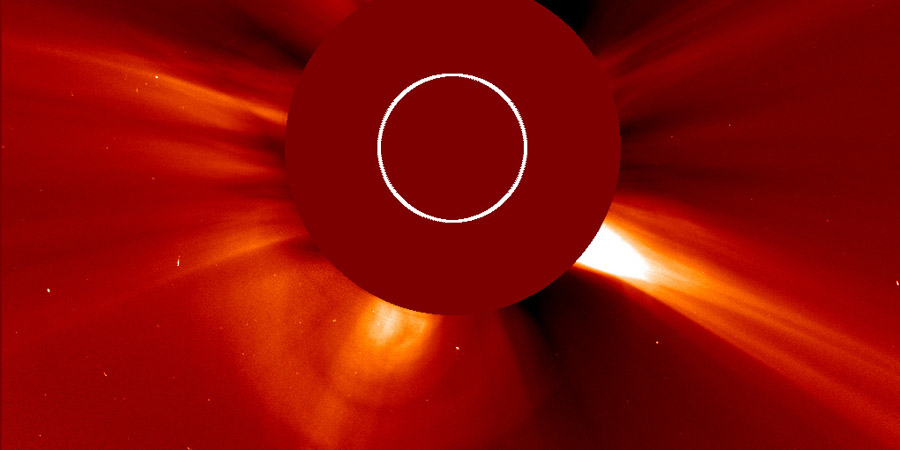
Yes you read that correctly. The Sun did not launch one, but two coronal mass ejections towards Earth yesterday.
One of these coronal mass ejections came from a C6.6 solar flare that took place yesterday at 09:03 UTC from sunspot region 2468 (CME 1) and another coronal mass ejection (CME 2) was launched right after that during a very complex eruption where sunspot region 2471 used to be.
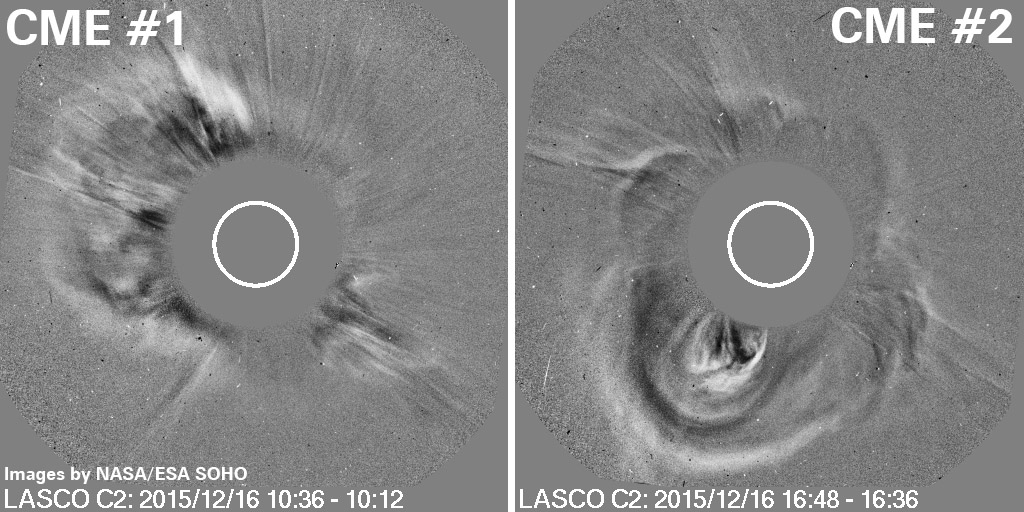
Image: the two halo coronal mass ejections as seen by ESA/NASA SOHO.
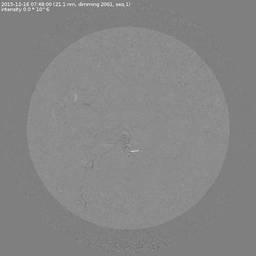
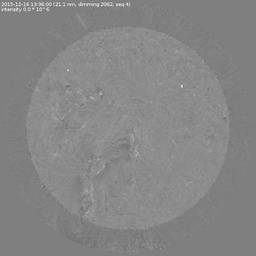
Animations: the two eruptions as seen by SDO. Credit: SIDC.
Two asymmetrical full halo coronal mass ejections became visible on the SOHO coronagraph images. The first coronal mass ejection looks like most of the ejecta will go east but as it's a full halo coronal mass ejection we are for sure going to see an impact at Earth.
The second coronal mass ejection also formed an asymmetrical full halo coronal mass ejection and will also likely arrive at Earth. Most of the ejecta is heading southeast but there is a solid chance that also this coronal mass ejection arrives at Earth.
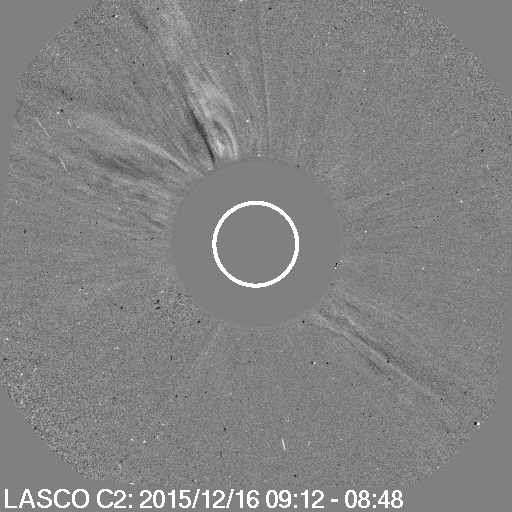
Animation: ESA/NASA SOHO/LASCO C2 imagery showing two asymmetrical full halo coronal mass ejections being launched towards Earth in just a few hours.
The SIDC gives us fairly low speeds for these coronal mass ejections. About 550km/s for the first coronal mass ejection and only 490km/s for the second coronal mass ejection.
It will however be very interesting to follow these events as two coronal mass ejections so close to each other is not something we see very often. The first CME should sweep up ambient solar wind which makes it easier for CME #2 to plow trough space. However, CME #1 looks faster than #2. The question is: will this speed difference cause them to arrive separately or will CME #1 slow down enough (because it has to plow trough ambient wind) so that CME 2 can catch up? The NOAA SWPC indeed thinks that the second CME will catch up with the first CME and arrive as one shockwave this Saturday around midnight UTC.
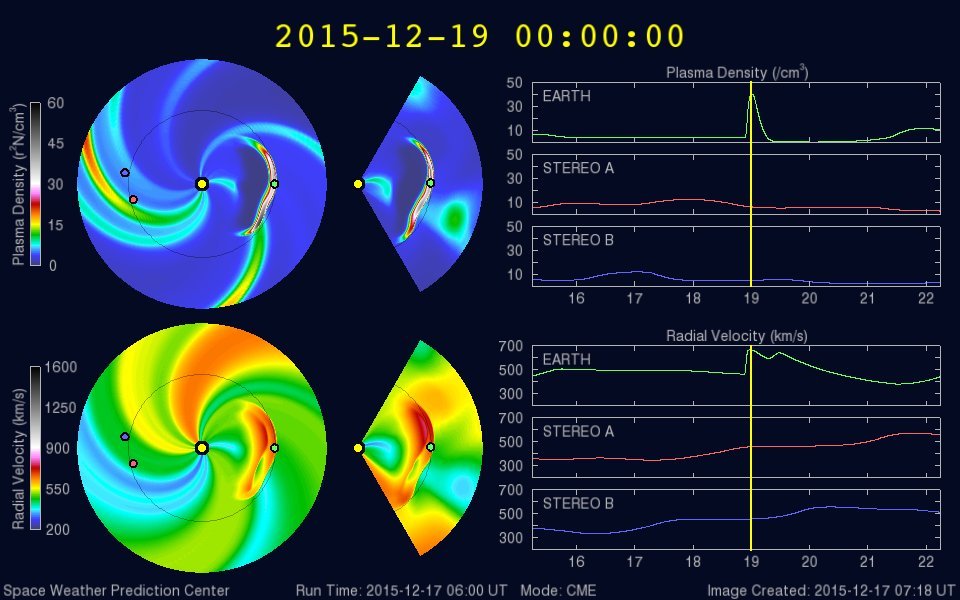
For our own analysis we used the Drag-Based model and used a speed of 550km/s for the first CME and a background solar wind speed of 400km/s and this gives us an arrival time which is a bit later than NOAA's anticipated arrival time. We estimate that this coronal mass ejection will arrive around 12:00 UTC (+/- 6 hours) on Saturday 19 December, 2015.
A minor G1 geomagnetic storm watch is in effect for Saturday 19 December, 2015. The speed of these coronal mass ejections is just too low to suggest we are likely to see stronger storm levels but there is one vital piece of the puzzle that we do not know about and that is the IMF. Two coronal mass ejections close together are known to cause a compressed IMF (higher Bt) which in turn could cause a stronger geomagnetic storm if the direction of the IMF (Bz) turns southward.
So a lot of unknowns for these two solar storms, we definitely recommend you to keep following us on Saturday to see how this event is going to unfold.
Thank you for reading this article! Did you have any trouble with the technical terms used in this article? Our help section is the place to be where you can find in-depth articles, a FAQ and a list with common abbreviations. Still puzzled? Just post on our forum where we will help you the best we can!
Latest news
Latest forum messages
Support SpaceWeatherLive.com!
A lot of people come to SpaceWeatherLive to follow the Sun's activity or if there is aurora to be seen, but with more traffic comes higher server costs. Consider a donation if you enjoy SpaceWeatherLive so we can keep the website online!

Space weather facts
| Last X-flare | 2025/02/23 | X2.0 |
| Last M-flare | 2025/03/11 | M1.1 |
| Last geomagnetic storm | 2025/03/13 | Kp5 (G1) |
| Spotless days | |
|---|---|
| Last spotless day | 2022/06/08 |
| Monthly mean Sunspot Number | |
|---|---|
| February 2025 | 154.6 +17.6 |
| March 2025 | 119.8 -34.8 |
| Last 30 days | 143 -4.6 |


